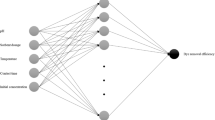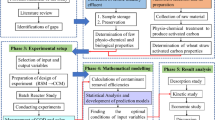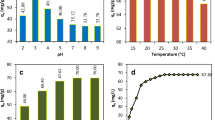Abstract
Olive mill wastewater (OMW) is classified as highly pollutant-containing wastewater that must be treated to an acceptable level before being discharged into receiving water environments. Recently, many chemical matters have been widely used in OMW treatment, but their harmful chemical structures have caused various health and environmental problems and have been economically challenging. Therefore, this research presents the use of natural grape molasses soil as a chemical coagulant for OMW treatment. An artificial neural network (ANN) modeling technique was used to predict effluent color and chemical oxygen demand (COD) results after the coagulation-precipitation process. The input variables of the ANN process were mixing time, mixing speed, amount of grape molasses soil, effluent pH, and effluent turbidity, while the responses of the ANN were effluent color (λ436, λ525, and λ620) and effluent COD. Twelve different training algorithms were used to develop the ANN model. Bayesian regularization (trainbr) indicated to be the best backpropagation training algorithm with the lowest mean-squared error (0.0089). The appropriate architecture of an ANN-based model for use in effluent color and COD prediction consists of 5 input variables, tangential sigmoid transfer function (tansig) in 10 hidden layer neurons, and a linear transfer function (purelin) in 4 output layer neurons. The ANN testing R2 for effluent color (λ436, λ525, and λ620) and effluent COD has been determined to be 0.9742, 0.9711, 0.9624, and 0.8773, respectively. It is necessary to model and optimize the chemical treatment process with grape molasses soil of OMW in the search for a more efficient and economical process. This study enabled a reduction in the electricity required and the amount of coagulant consumed by optimizing the mixing time, mixing speed, and the amount of grape molasses soil added. The results proved that the proposed ANN performed well in predicting the effluent color and effluent COD with the use of natural grape molasses soil while avoiding economic and environmental sustainability problems.
Graphical abstract









Similar content being viewed by others
Data Availability
The datasets used and/or analyzed during the current study are available from the corresponding author on reasonable request.
References
Hodaifa, G., Malvis, A., Maaitah, M., & Sánchez, S. (2020). Combination of physicochemical operations and algal culture as a new bioprocess for olive mill wastewater treatment. Biomass and Bioenergy, 138, 105603. https://doi.org/10.1016/j.biombioe.2020.105603
Domingues, E., Rodrigues, F., Gomes, J., Quina, M., Castro-Silva, S., & Martins, R. (2020). Screening of low-cost materials as heterogeneous catalysts for olive mill wastewater Fenton’s peroxidation. Energy Reports, 6, 161–167. https://doi.org/10.1016/j.egyr.2020.11.095
Achak, M., Boumya, W., Ouazzani, N., & Mandi, L. (2019). Preliminary evaluation of constructed wetlands for nutrients removal from olive mill wastewater (OMW) after passing through a sand filter. Ecological Engineering, 136, 141–151. https://doi.org/10.1016/j.ecoleng.2019.06.007
Kuşçu, Ö. S., & Eke, E. (2021). Oxidation of olive mill wastewater by a pulsed high-voltage discharge using oxygen or air. Journal of Environmental Chemical Engineering, 9(1), 104701. https://doi.org/10.1016/j.jece.2020.104701
Lee, Z. S., Chin, S. Y., Lim, J. W., Witoon, T., & Cheng, C. K. (2019). Treatment technologies of palm oil mill effluent (POME) and olive mill wastewater (OMW): A brief review. Environmental Technology & Innovation, 15, 100377. https://doi.org/10.1016/j.eti.2019.100377
Tsagaraki, E., Lazarides, H. N., & Petrotos, K. B. (2007). Olive mill wastewater treatment. Utilization of by-products and treatment of waste in the food industry (pp. 133–157). Springer.
Mantzavinos, D., & Kalogerakis, N. (2005). Treatment of olive mill effluents: Part I. Organic matter degradation by chemical and biological processes–an overview. Environment International, 31(2), 289–295. https://doi.org/10.1016/j.envint.2004.10.005
Paraskeva, C., Zagklis, D., Arvaniti, E., & Papadakis, V. (2012). Olive mill wastewater treatment methods: Sustainability and benchmarking. Prosodol Symposium on “Olive Mill Wastes and Environmental Protection (pp. 16–18). Chania, Greece.
Lolos, G., Skordilis, A., & Parissakis, G. (1994). Polluting characteristics and lime precipitation of olive mill wastewater. Journal of Environmental Science & Health Part A, 29(7), 1349–1356. https://doi.org/10.1080/10934529409376115
Aktas, E. S., İmre, S., & Ersoy, L. (2001). Characterization and lime treatment of olive mill wastewater. Water Research, 35(9), 2336–2340. https://doi.org/10.1016/S0043-1354(00)00490-5
Boukhoubza, F., Jail, A., Korchi, F., Idrissi, L. L., Hannache, H., Duarte, J., Hassani, L., & Nejmeddine, A. (2009). Application of lime and calcium hypochlorite in the dephenolisation and discolouration of olive mill wastewater. Journal of Environmental Management, 91(1), 124–132. https://doi.org/10.1016/j.jenvman.2009.07.004
Sağlık, S., Ersoy, L., & İmre, S. (2002). Oil recovery from lime-treated wastewater of olive mills. European Journal of Lipid Science and Technology, 104(4), 212–215.
Tsonis, S. P., Tsola, V. P., & Grigoropoulos, S. G. (1989). Systematic characterization and chemical treatment of olive oil mill wastewater. Toxicological & Environmental Chemistry, 20(1), 437–457. https://doi.org/10.1080/02772248909357407
Uğurlu, M., & Kula, İ. (2007). Decolourization and removal of some organic compounds from olive mill wastewater by advanced oxidation processes and lime treatment. Environmental Science and Pollution Research-International, 14(5), 319–325. https://doi.org/10.1065/espr2006.06.315
Baştürk, E., & Alver, A. (2019). Modeling azo dye removal by sono-fenton processes using response surface methodology and artificial neural network approaches. Journal of Environmental Management, 248, 109300. https://doi.org/10.1016/j.jenvman.2019.109300
Şenol, H. (2021). Methane yield prediction of ultrasonic pretreated sewage sludge by means of an artificial neural network. Energy, 215, 119173. https://doi.org/10.1016/j.energy.2020.119173
Tufaner, F., & Demirci, Y. (2020). Prediction of biogas production rate from anaerobic hybrid reactor by artificial neural network and nonlinear regressions models. Clean Technologies and Environmental Policy, 22, 713–724. https://doi.org/10.1007/s10098-020-01816-z
Mojiri, A., Ohashi, A., Ozaki, N., Aoi, Y., & Kindaichi, T. (2020). Integrated anammox-biochar in synthetic wastewater treatment: Performance and optimization by artificial neural network. Journal of Cleaner Production, 243, 118638. https://doi.org/10.1016/j.jclepro.2019.118638
Bekkari, N., & Zeddouri, A. (2019). Using artificial neural network for predicting and controlling the effluent chemical oxygen demand in wastewater treatment plant. Management of Environmental Quality: An International Journal, 30(3), 593–608. https://doi.org/10.1108/MEQ-04-2018-0084
Yazdani, H., Khoshhal, A., & Mousavi, N. S. (2020). Evaluating the performance of a sequencing batch reactor for sanitary wastewater treatment using artificial neural network. Environmental Progress & Sustainable Energy, 39(6), e13438. https://doi.org/10.1002/ep.13438
Morales-Rivera, J., Sulbarán-Rangel, B., Gurubel-Tun, K. J., del Real-Olvera, J., & Zúñiga-Grajeda, V. (2020). Modeling and optimization of COD removal from cold meat industry wastewater by electrocoagulation using computational techniques. Processes, 8(9), 1139. https://doi.org/10.3390/pr8091139
de Leon, V. B., de Negreiros, B. A. F., Brusamarello, C. Z., Petroli, G., Di Domenico, M., & de Souza, F. B. (2020). Artificial neural network for prediction of color adsorption from an industrial textile effluent using modified sugarcane bagasse: Characterization, kinetics and isotherm studies. Environmental Nanotechnology, Monitoring & Management, 14, 100387. https://doi.org/10.1016/j.enmm.2020.100387
Battaloğlu, R. (2009). Investigation of the samples of marl gathered from Niğde city for the residues of pesticides and polycyclic aromatic hidrocarbon (PAH). Paper presented at the 1.Tıbbi Jeoloji Çalıştayı, Ürgüp/ NEVŞEHİR, 30 October - 1 November.
APHA. (2012). Standard methods for examination of water and wastewater (22nd ed.). Washington, DC, USA: American Public Health Association (APHA), American Water Works Association, Water Environmental Federation. Edited by Rice W. Eugene, Baird B. Rodger, & Eaton D. Andrew.
Daneshvar, N., Khataee, A., & Djafarzadeh, N. (2006). The use of artificial neural networks (ANN) for modeling of decolorization of textile dye solution containing CI Basic Yellow 28 by electrocoagulation process. Journal of Hazardous Materials, 137(3), 1788–1795. https://doi.org/10.1016/j.jhazmat.2006.05.042
Ezemagu, I. G., Ejimofor, M. I., Menkiti, M. C., & Nwobi-Okoye, C. C. (2021). Modeling and optimization of turbidity removal from produced water using response surface methodology and artificial neural network. South African Journal of Chemical Engineering, 35, 78–88. https://doi.org/10.1016/j.sajce.2020.11.007
Tufaner, F., Avşar, Y., & Gönüllü, M. T. (2017). Modeling of biogas production from cattle manure with co-digestion of different organic wastes using an artificial neural network. Clean Technologies and Environmental Policy, 19(9), 2255–2264. https://doi.org/10.1007/s10098-017-1413-2
Pérez-Pérez, E., López-Estrada, F., Valencia-Palomo, G., Torres, L., Puig, V., & Mina-Antonio, J. (2021). Leak diagnosis in pipelines using a combined artificial neural network approach. Control Engineering Practice, 107, 104677. https://doi.org/10.1016/j.conengprac.2020.104677
Samadani, M., Kitio Kwuimy, C., & Nataraj, C. (2013). Diagnostics of a nonlinear pendulum using computational intelligence. ASME 2013 Dynamic Systems and Control Conference, 21–23 October 2013 (pp. 1–8). Palo Alto, California, USA: American Society of Mechanical Engineers.
Teke, A., Yıldırım, H. B., & Çelik, Ö. (2015). Evaluation and performance comparison of different models for the estimation of solar radiation. Renewable and Sustainable Energy Reviews, 50, 1097–1107. https://doi.org/10.1016/j.rser.2015.05.049
Madadlou, A., Emam-Djomeh, Z., Mousavi, M. E., Ehsani, M., Javanmard, M., & Sheehan, D. (2009). Response surface optimization of an artificial neural network for predicting the size of re-assembled casein micelles. Computers and Electronics in Agriculture, 68(2), 216–221. https://doi.org/10.1016/j.compag.2009.06.005
Akkoyunlu, A., Yetilmezsoy, K., Erturk, F., & Oztemel, E. (2010). A neural network-based approach for the prediction of urban SO2 concentrations in the Istanbul metropolitan area. International Journal of Environment and Pollution, 40(4), 301–321. https://doi.org/10.1504/IJEP.2010.031752
Chellali, M., Abderrahim, H., Hamou, A., Nebatti, A., & Janovec, J. (2016). Artificial neural network models for prediction of daily fine particulate matter concentrations in Algiers. Environmental Science and Pollution Research, 23(14), 14008–14017. https://doi.org/10.1007/s11356-016-6565-9
Najafi, B., & Ardabili, S. F. (2018). Application of ANFIS, ANN, and logistic methods in estimating biogas production from spent mushroom compost (SMC). Resources, Conservation and Recycling, 133, 169–178. https://doi.org/10.1016/j.resconrec.2018.02.025
Chithra, S., Kumar, S. S., Chinnaraju, K., & Ashmita, F. A. (2016). A comparative study on the compressive strength prediction models for high performance concrete containing nano silica and copper slag using regression analysis and artificial neural networks. Construction and Building Materials, 114, 528–535. https://doi.org/10.1016/j.conbuildmat.2016.03.214
Yonar, T., & Kilic, M. Y. (2014). Chemical oxygen demand and color removal from textile wastewater by UV/H2O2 using artificial neural networks. Water Environment Research, 86(11), 2159–2165. https://doi.org/10.2175/106143014x14062131178277
Yu, R.-F., Chen, H.-W., Cheng, W.-P., & Hsieh, P.-H. (2009). Dosage control of the Fenton process for color removal of textile wastewater applying ORP monitoring and artificial neural networks. Journal of Environmental Engineering, 135(5), 325–332. https://doi.org/10.1061/(ASCE)EE.1943-7870.0000016
Elmolla, E. S., Chaudhuri, M., & Eltoukhy, M. M. (2010). The use of artificial neural network (ANN) for modeling of COD removal from antibiotic aqueous solution by the Fenton process. Journal of Hazardous Materials, 179(1–3), 127–134. https://doi.org/10.1016/j.jhazmat.2010.02.068
Maslahati Roudi, A., Chelliapan, S., Wan Mohtar, W. H. M., & Kamyab, H. (2018). Prediction and optimization of the fenton process for the treatment of landfill leachate using an artificial neural network. Water, 10(5), 595. https://doi.org/10.3390/w10050595
Arabameri, M., Javid, A., & Roudbari, A. (2017). Artificial neural network (ANN) modeling of COD reduction from landfill leachate by the ultrasonic process. Environment Protection Engineering, 43(1), 59–73. https://doi.org/10.37190/epe170105
Author information
Authors and Affiliations
Contributions
The plan, design of the study, data collection, initial draft, supervision of the work, revision, and all other work were done by FT. The manuscript was read in detail and approved.
Corresponding author
Ethics declarations
Ethical Approval and Consent to Participate
Not applicable.
Consent for Publication
Not applicable.
Competing Interests
The authors declare no competing interests.
Additional information
Publisher's Note
Springer Nature remains neutral with regard to jurisdictional claims in published maps and institutional affiliations.
Rights and permissions
Springer Nature or its licensor holds exclusive rights to this article under a publishing agreement with the author(s) or other rightsholder(s); author self-archiving of the accepted manuscript version of this article is solely governed by the terms of such publishing agreement and applicable law.
About this article
Cite this article
Tufaner, F. The Use of Artificial Neural Networks for Modeling Color and Chemical Oxygen Demand Removal from Olive Mill Wastewater Using Grape Molasses Soil. Environ Model Assess 27, 855–868 (2022). https://doi.org/10.1007/s10666-022-09852-3
Received:
Accepted:
Published:
Issue Date:
DOI: https://doi.org/10.1007/s10666-022-09852-3




